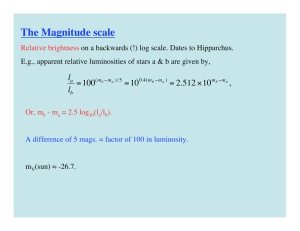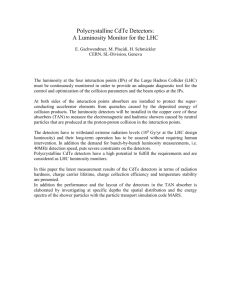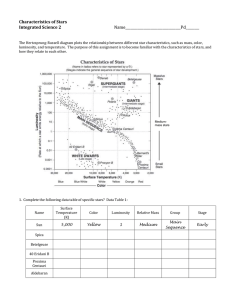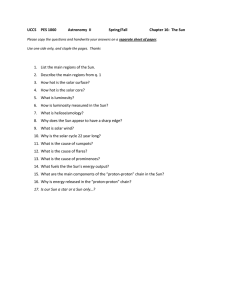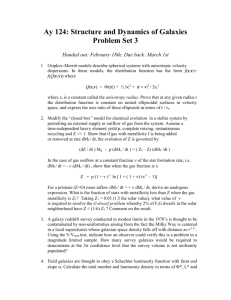CMS Luminosity Measurement(s) Cornell Journal Club Daniel Marlow
advertisement
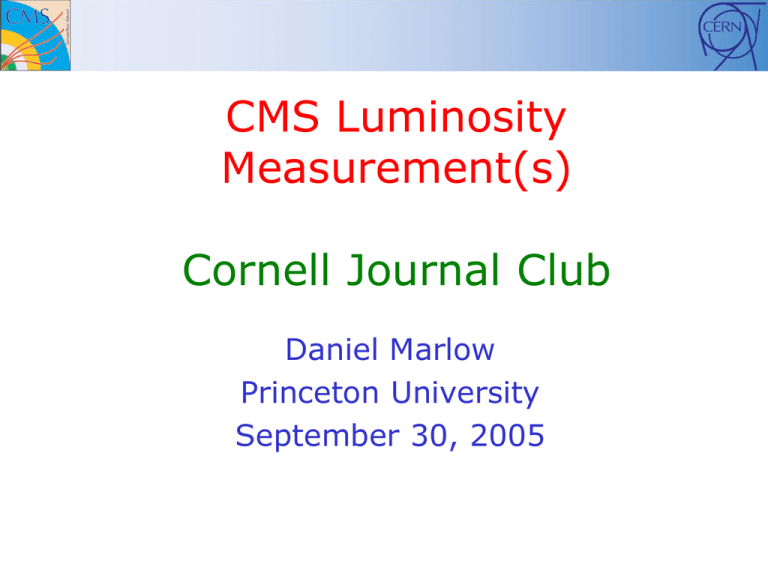
CMS Luminosity Measurement(s) Cornell Journal Club Daniel Marlow Princeton University September 30, 2005 Talk Outline • Goals & General Strategy • Real time Techniques – HF – Pixel Telescopes – TAN-region Fast Ionization Chamber • Offline Techniques – Total cross section measurement (TOTEM) – W & Z Counting • Bookkeeping • Other Issues Design Goals: General Desirables • Absolute calibration, based on a known cross section with a reliably calculated acceptance. • Temporal stability against gain changes and other drifts: “countable objects” or self calibrating signals (e.g., MIP peak). • Linearity over a large range of luminosities. • Real time operation independent of full DAQ. • Redundancy – There is no perfect method – Applies to both real time monitoring and to offline absolute normalization Design Goals: Specific Issues • Real time monitoring – Bunch by bunch (yes) – Update time: 0.1 s to 1.0 s or slower • Offline – Robust logging – Easy access to luminosity records – Dynamic range (1028 ~ 1034 cm–2s–1) • Absolute Calibration – Target from previous workshops 5% (or better) General Strategy • Use TOTEM* measurement of total cross section at low luminosity as a reference point. • Use real time techniques (HF, Pixel Telescopes, FIC) to extrapolate/interpolate to design luminosity • Renormalize at design luminosity using processes of ~known cross section (e.g., W’s and Z’s) *TOTEM is a forward detector that will measure the total p-p cross section, thus providing a normalization point. Lumi Basics • Apologies to the experts! • Basic equation N event Ldt • We are often interested in the mean number of interactions per bunch crossing: filled BX N mb L BX f 2835 f 40 MHz 3564 total BX Zero Counting • If μ<<1 measuring the luminosity is straightforward, since the probability of two events in a single BX is ~μ2 . It is enough just to count hits. • For μ~1, one must either be able to distinguish between single and double interactions (not generally possible in this context), or, one must “count zeroes” p(n; ) n e p(0; ) e n! log[ p(0)] Zero Counting • For μ>>1, one starts to run out of zeroes to count. There is no hard limit, but requiring at least 1% zeroes seems reasonable. This corresponds to log(. 01) 4.6 General Strategy Extrapolation of the total cross section as measured by TOTEM involves six orders of magnitude,* over which the number of min bias interactions goes from ~10-5 to ~25 per BX. *The extrapolation is not quite so bad, since TOTEM running will be done with fewer filled bunches. High L Zero famine Zero feast TOTEM Importance of Bunch-byBunch Measurements • Presumably bunch-by-bunch luminosity information is of interest to the machine people. • But it may also be relevant to physics simulations. In particular, if there are significant bunch-to-bunch variations in the luminosity, then the distribution of the number of underlying interactions will no longer be Poisson. Importance of Bunch-byBunch Measurements • To see the effect, we consider the case where the bunch-to-bunch variations in the mean number of expected interactions is Gaussian distributed. • The cases considered range from no smearing (all bunch luminosities the same) to 50% bunchto-bunch variations. Importance of Bunch-by-Bunch Measurements pure Poisson 10% smearing 20% smearing 50% smearing The “HF” The simulation results to be presented here will deal exclusively with the HF. HF HF is fast and transverse shower size is small 5mm HAD (143 cm) To cope with high radiation levels (>1 Grad accumulated in 10 years) the active part is Quartz fibers: the energy measured through the Cherenkov light generated by shower particles. This is the cause of two of the peculiar features of this calorimeter: EM (165 cm) The visible energy is carried by relativistic particles, i.e. electrons: the calorimeter is sensitive to the EM component (p0) of the hadronic shower. Shower size depends on Moliere radius not li Iron calorimeter Covers 5 > h > 3 Total of 1728 towers, i.e. 2 x 432 towers for EM and HAD The light is generated preferentially at 45 degrees: light propagation is h x f segmentation (0.175 x 0.175) far from ‘usual’ meridian one. from Greg Snow Dec. 2002 Signals From HF Iron fiber calorimeter. 3<η<5 HF Minimal add’l hardware requirements •Mezzanine board to tap into HF data stream and forward bits to a PC via Ethernet •Autonomous (mini) DAQ system to provide “always on” operation T1 & T2 are elements of TOTEM HF Energy Depositions The energy depositions in single interactions are typically quite sparse. Simulation details: • PYTHIA w. diffractive events added. • DC04 (GEANT) • Extract HF depositions to Rootuple. Energy Depositions At design luminosity, there are typically 25 interactions per BX. ET Depositions Diffractive interactions An ET threshold of 1 GeV will detect most interactions. Total in one endcap. Single interaction BX’s only. HF Methods & Simulation Methods: • Count minimum bias events at low luminosity • Count “zeroes” at design luminosity • Use also linear ET sum, which scales directly with luminosity. Simulation Information: • Recent work by Chris Rogan, Princeton undergrad. • Thanks to Monika Grothe & Wisconsin group for providing MC samples with diffractive events included. • MC details – – – – – Full GEANT & ORCA 0.25 p.e./GeV QIE FADC scale realistically included Thermal noise included Tested performance over a range of assumptions HF Zero Counting • Defeat the zero famine at high luminosity by counting zeroes in a much smaller solid angle. • There are 864 HF “physical” towers. • In effect these provide 864 quasi-independent measurements of the luminosity. • Average to arrive at final result. MC Results: Physical Tower Zero Counting <N>/Nexpected <N>/BX Zero starvation 3 FADC count hit threshold Line is determined by value at 1034 , not a fit. Deviation from linearity <N>/Nexpected <N>/BX Physical Tower Zero Counting w. Increased Threshold Thresholds ~2X previous plot Superlinearity typical of high thresholds <ET>/ETexpected <ET>/BX (GeV) MC Results: ET Sum Method Line is determined by value at 1034 , not a fit. This is the average ET summed over the HF for each BX. Nominal noise and threshold (ADC least count effects included). Effect of noise at low luminosity. Deviation from linearity <ET>/ETexpected <ET>/BX (GeV) MC Results: ET Sum Method Noise Subtracted Deviation from linearity HF Luminosity Readout Path • 9 HTRs for HF+ and HF• Each HTR has 1 output with luminosity info – 100Mbps raw ethernet packets sent to router • Router to computer over Gigabit ethernet • Dead time, throttle, etc. info from GCT sent to CPU • This computer will feed LHC, luminosity DB, etc. HF H T R H T R R O U T E R 9 HTRs/VME crate HF + H T R Global Trigger H T R CPU Luminosity consumers Maryland/Princeton/Virginia HF Luminosity Card • Initial prototype board built. Next version due back TO P soon. – 32MBytes of SDRAM – Virtex2PRO/VP7 has 722kbits block ram – Embedded processor • Function: – Receive data @ 40MHz from each Xilinx – Keep running sum of tower occupancy per bucket – Keep ethernet blasts in memory for transmission BO T Pixel Luminosity Telescope (PLT) • The HF method is based on an existing detector, and thus has the advantage of being inexpensive and relatively easy to implement. • It does not, however, really fit the bill when it comes to providing a luminosity measurement based on “countable objects.” • Motivated by the CDF approach of counting MIPs using Cherenkov telescopes, we are proposing a charged-particle telescope system based on single crystal diamond detectors. • This system is not yet fully funded. Pixel Luminosity Telescope (PLT) Measure luminosity bunch-by-bunch • Small angle (~1o) pointing telescopes • Three planes of diamond sensors (8 mm x 8 mm) • Diamond pixels bump bonded to CMS pixel ROC • Form 3-fold coincidence from ROC fast out signal • Located at r = 4.5 cm, • Total length 20 cm • Eight telescopes per side Count 3-fold coincidences on bunch-by-bunch basis. Simple, stand alone detector, operating independently of main CMS DAQ z = 175 cm Rutgers/Princeton/UC Davis Single Crystal (SC) CVD Diamond • Radiation hard (few x 1015 cm-2) • No need for cooling • Full charge collection at 0.2 V / m ― 18,000 e― for 500 m diamond ― Landau 60% narrower than Si • Availability of 8 mm x 8mm pieces ― 2 pieces end of last year ― 8 pieces in May ― ready for production by Fall • Test performance of irradiated diamond pixel detectors ― efficiency ― spatial resolution ― radiation hardness Fall Fermilab test beam Polycrystalline Diamond Single Crystal: • distribution well separated from zero Polycrystalline: crystal boundaries • wide distribution • low pulse height tail • charge spreading over several pixels very difficult to achieve 1% stability of efficiency using polycrystaline sensors CMS Pixel Readout Chip CMS pixel chip has “fast” multiplicity counting built in 80 x 52 pixels 100 m x 150 m active area 8 mm Fast output level (each bunch crossing) • 0, 1, 2, 3, 4 double column hits • individual pixel thresholds adjustable • individual pixels can be masked 8 mm Full pixel readout (every L1 trigger) • pixel address and pulse height of each hit • diagnostic of fast out signal • determination of track origin • determination of IP location IP* σxy~35 μm σz~700 μm Scattering Beam halo *statistical accuracy on relative position assuming 1033 for 1 s Location • End of Be section of beam pipe (~ 1.7 m from IP) • Just outside of beam pipe (~ 4 cm from beam line) IP Luminosity telescopes Rates for L = 1033 Pythia 6.227 -- CMS Min. Bias productiin • interactions per BC: 2.5 • number of buckets per orbit: 3564 • filled buckets per orbit: 2835 • tracks per telescope per BC: 0.053 • tracks per array per BC: 0.84 • tracks per telescope per 1 s: 1.7 x 106 • tracks per array per 1 s: 2.7 x 107 • tracks per array per bucket per 1 s: 9500 1.0% statistical luminosity accuracy per bucket per 1 s @ L = 1033 • ratio of coin./tracks for 18 int. per BC: 0.81 Backgrounds increase when beam pipe and CMS detector material put in Coincidences: 11% almost all coming from photons from pi0’s interacting in beam pipe Singles rate: 77% sources mostly from beam pipe some from pixel detector accidental hits per plane per interaction: 0.02 24% fakes in 3-fold coincidences @ L =1034 (assuming accidentals not correlated) Sources of Hits • hadrons from physics (IP) hadron coincidences • electrons from physics (p0 photon conversions in beam pipe) • singles from IP, beam pipe, pixel detector, telescope planes electron coincidences singles 8 telescopes per side φ=0 Top and Bottom of the 3rd plane reduced by 0.5mm 8 telescopes per side φ=22.5 Top and Bottom of the 3rd plane reduced by 0.5mm 4 telescopes per side φ=45 Top and Bottom of the 3rd plane reduced by 1mm PLT Status • The PLT is an ideal real-time luminosity monitor. • A detailed design showing the PLT to be compatible with CMS has been worked out, simulation studies are well advanced, and work on verifying the single-crystal diamonds is in progress. • The required funding of ~$300K has not been secured, but we are pursuing various avenues and remain optimistic. • The BCM mechanical mount will accommodate the PLT. LHC Luminosity Monitor • The LHC accelerator project* plans to incorporate fast ionization counters (FICs) in the TAN region, which is ±140m from the IP. TAN TAN D1 triplet TAS TAS triplet D1 L n R 140 m IP 140 m *US LARP project in particular. LHC Luminosity Monitor Instrumented Cu bar absorber to IP FIC, which is integrated with the ZDC, is located at the position of the beam septum. LHC Luminosity Monitor Target specifications: • <0.5% relative precision • Long term stability (~1 month) for calibration with detectors • High radiation environment (100 MGy/year) • Bunch-by-bunch capability Solution • Segmented, multi-gap, pressurized ArN2 gas ionization chamber constructed of rad-hard materials Quadrant segmentation provides sensitivity to beam position. LHC Luminosity Monitor The drift speed in the FIC is such that resolving individual bunches is an issue. The strategy being pursued consists of analog pulse shaping combined with digital deconvolution. Step 25k 1 1 to 10 2 to 10 3 to 10 4 to 10 5 to 10 6 to 10 7 to 10 8 to 10 9 to 10 10 5 mVolts 4 3 2 1 0 0.8 Channel output [V] 6 0.6 Out @ 20 PP int + 1 PP int 0.4 0.2 0 Out @ 20 PP int 0 50 100 150 nsec 200 250 300 350 -0.2 -20 0 20 40 t [ns] 60 80 100 LHC Luminosity Monitor •Project is part of LARP, a consortium of US labs participating in LHC accelerator work. •This project is led by LBL. •The current plan is to provide information to the LHC machine group. •I am in contact with the LBL people and I am working toward getting the information for incorporation into the CMS real time luminosity database. TOTEM Luminosity Independent Method Measure elastic scattering in Roman Pots and inelastic in T1 and T2 (see next slide). Should give result good to ~1% or so. Normalization Using W’s and Z’s M. Dittmar et al. Basic idea is to use pp W & pp Z + • Lots of rate • Well understood theoretically • Readily detectable LHC event rates at 'nominal luminosity' CMS Trigger TDR Normalization Using W’s and Z’s • For a typical process we have N pp X 2 partonsX PDF( x1 , x2 , Q ) Lproton-proton • If we take pp Z as a reference process, with N ppZ ( q qZ + ho ) PDF ( x1 , x2 , Q 2 ) Lprotonproton • The ratio does not depend on the luminosity or the pp cross section. N ppX N pp Z q q X q qZ PDF( x1, x2 , Q2 ) PDF( x1 , x2 , Q 2 ) Bookkeeping and Normalization Consider a process j, whose cross section we wish to measure j N yield j j L0 yield triggered N 1 1 j triggered N j N j j j L0 N triggered j L0 j where N yield is the event yield in the final sample j triggered (background removed by cuts and fitting), N j is the raw number of triggers, εj is the selection efficiency (trigger plus offline), and L0 is the luminosity, uncorrected for either deadtime or prescaling. A CMS Note on this is in preparation. . . .General Considerations Note that N yield j j triggered , Nj which is the fraction of all events that pass the analysis cuts, can be determined from any unbiased sample of triggers. Note that all one needs to know is the raw number of triggers. Dead times and prescale factors do not explicitly enter (of course, one would want to know these as cross checks). A similar analysis (too complicated for a short talk) shows that multiple overlapping triggers with arbitrary prescales can also be accommodated. Technical Requirements • A hardware scaler that counts L1A’s before any prescaling or deadtime losses are applied. • We need to know the fraction of events rejected by the HLT. • This information must be “coordinated” with the scaler and luminosity information. Summary and Conclusions • Various techniques are being pursued for online luminosity monitoring. • HF • PLT • FIC • The combination should provide redundancy and cross checks. • A simple and robust strategy for obtaining offline normalization has been formulated. Extra Slides ET Depositions Most of the energy depositions in the physical towers are below 1 GeV Location of IP Centroid Relative location of IP • L = 1033 assume readout rate of 30 kHz about 1200 tracks per telescope per 1 s σx = 2.4 mm • σz = 90 mm • • 4 telescopes involved in x (or y) measurement • 16 telescopes involved in z measurement @ L = 1033 in 1 s 35 m centroid precision in x (or y) 700 m centroid precision in z Absolute location of IP • assume 300 um relative alignment of planes 1.5 mm in x (or y) 30 mm in z IP Distributions X x = 2.4 mm y = 5.9 mm z = 89 mm smeared because of track curvature and longitudinal beam length (σ~7.5 cm) Y Z What’s Needed Many parts developed for CMS pixel detector • • • • • • • ROC (pixel readout chip) TBM (readout control chip) FEC (VME control link module) FED (VME flash ADC module) Optical links Port Card (board for housing lasers, photodiodes,power distribution) Fan in/out chip (chip for fan out/in of control lines) A few need to be custom developed • • • • • HDI (circuit on which sensors are mounted) Bump bonded sensors Custom chip Support structure DAQ board (circuit for histograming of fast out signals) Bump Bonding • Bumping of readout chips done at PSI as part of pixel project • Metallization of diamond Ti/W pixel electrodes, capability at Rutgers • Bumping of individual diamond pieces UC, Davis has successfully done this in the past • Flip chipping UC, Davis has capability • Total of 48 pieces need to be bump bonded • 100 % pixel yield not required • Diamond sensor can be reworked if bumping fails TOTEM & CMS HF T1 •Need common TOTEM/CMS running to cross normalize inelastic cross section. •Effect of removing T1? T2 CASTOR
